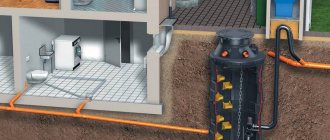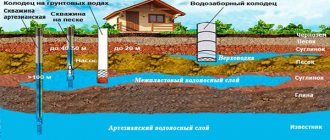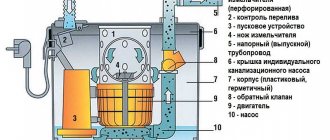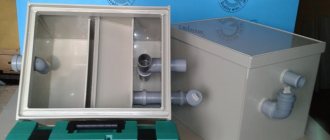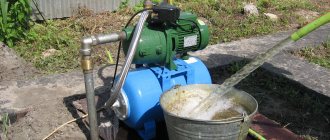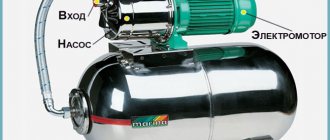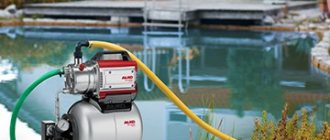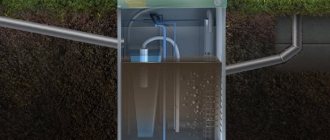In situations where it is impossible to ensure the required slope of the sewer pipe, the gravity drainage scheme does not work. In these cases, a sewage pumping station is indispensable, ensuring unhindered outflow and recycling of waste.
There are two types of units: mini-stations and full-functional complexes for home maintenance. Let’s figure out which option is better to give preference to, what characteristics should be taken into account when choosing. In addition, we will describe step-by-step installation technology and operating rules for the sewer station.
Areas of application and purpose of CNS
A sewage pumping station (SPS) is an integral complex of hydraulic equipment, which is designed for pumping storm water, industrial and domestic wastewater when their gravity discharge is impossible.
Pumping stations can have an additional horizontal cavity to distribute sludge over a larger area, which allows for less sludge removal
CNS is used mainly in the following cases:
- The geodetic level of the tanks and pipelines from which wastewater is discharged is located below the sewer or cesspool.
- Lack of physical ability to organize straight-line gravity drainage of wastewater or a small slope of the sewer pipe, which threatens its regular clogging.
- The cesspool or central collector is located far from the source of wastewater.
Cottage villages, country houses, as well as industrial facilities located far outside the city and remote from the centralized sewer network are equipped with sewage pumping stations.
Pumps
Under different operating conditions, different types of pumps can be used. Their choice depends on a number of factors:
- features of wastewater;
- the need to install mechanical cleaning elements;
- location of the pumping station housing;
- pump cooling conditions.
To select the correct pumping equipment, it is necessary to take into account the layout of the entire sewer installation. For these purposes, the system performance characteristics are calculated.
Equipment selection rules
Next, the criteria will be analyzed, taking into account which it is necessary to select sewage pumping equipment for private use. Analysis of industrial installations is beyond the scope of this review.
The goal when purchasing a pumping station is to purchase equipment that is optimal in terms of power and other characteristics. There is no point in overpaying for systems that will operate at 10-20% of their designed capacity.
When choosing a CNS, the following parameters are taken into account:
- Maximum flow of processed waste.
- Transport distance.
- The difference in geodetic levels between the inlet pipe and the outlet of the pressure hose.
- Degree of pollution, fractional composition and structure of domestic wastewater. There are pumping stations that crush large fractions of inclusions, preventing blockages in pumping equipment.
- Level of wastewater treatment required.
- Equipment dimensions.
There is no single formula for calculating the performance of pumping equipment, therefore the calculation algorithm and the necessary indicators must be specified in the instructions for the purchased pumping station.
A typical project for calculating the performance of pumping equipment includes the following steps:
- Determination of daily water consumption and wastewater volume.
- Construction of an approximate schedule for the flow of sewage wastewater during the day.
- Calculation of minimum and maximum sewer flow.
- Determination of the required productivity of the pumping station, taking into account the contamination of wastewater.
After determining the above parameters, you can begin to select the appropriate equipment.
The price of a pumping station is influenced by the manufacturer’s brand, the maintainability of the product, and the possibility of service. It is especially not recommended to purchase cheap pumps if they are expected to be used daily, and there are no reserve tanks or an additional pump for drainage.
Installation instructions for pump station
Installation of household pumping stations is carried out exclusively by qualified workers, due to the high requirements for the accuracy of work and compliance with the sequence of actions.
Failure to comply may result in damage to the tank or associated pipes. Next, we will consider step-by-step instructions for installing the CNS for people who want to do it themselves.
Step #1 . The location for installation of the pumping station is being selected. SNiPs require digging a tank at least 20 m from the walls of a residential building. If geodetic levels allow, then it is advisable to choose a higher site so that a lot of groundwater does not accumulate under the station.
KNS should not be installed on the front side of the house, near children's playgrounds and near picnic areas
Step #2 . A hole is dug taking into account the diameter of the container and the location for convenient installation work. If the soil is obtained by an excavator, then work must be stopped 20-30 cm above the design level. Next, the soil must be removed manually with a shovel to maintain the integrity of the soil.
When digging a hole for a sewer tank, you do not need to make it huge. A diameter 1.5-2 meters larger than the size of the container itself will be sufficient.
Step #3 . The type of foundation for installing the water pumping station is selected and installed. To do this, after digging a hole, the soil water content is assessed. If the soil is dry, then you can make formwork and fill it with a 30-centimeter layer of concrete.
And if groundwater constantly seeps into the pit, then only a ready-made reinforced concrete slab with a thickness of at least 30 cm is suitable for the foundation.
The concrete base must be strictly horizontal, so when laying the finished concrete slab you need to take care of this in advance.
KNS containers have a skirt or legs for attaching to the foundation. Anchor bolts are used as fasteners, although when pouring concrete onto the ground, metal rods can also be built into the mixture, onto which the container can then be attached.
You should not skimp on the size of the anchor bolts. Their optimal length is 200 mm and diameter is 20 mm. And before laying in liquid concrete, metal rods must be bent with a hook or the letter G (+)
Step #4. The water pumping station tank is installed on the foundation, secured and connected to the drain pipe of the internal sewer system of the house. With a vertical type of station and a large amount of groundwater, it is necessary to load the container with concrete. To do this, concrete is poured around the tank 20 cm above the level of the first stiffener of the station.
It should be borne in mind that after pouring concrete it will be impossible to change the tank, so it is necessary to calculate its volume taking into account the expansion of the house and the increase in the number of its residents
Step #5 . The station is backfilled with fine soil, the maximum grain size of which is 32 mm. Each layer of earth should be no more than 50 cm. After filling the next belt, it is filled with water for shrinkage and compacted.
This completes the external installation of the pump station. After being fixed in the ground, pumps, sensors, check valves and other auxiliary equipment are installed inside the station.
For safety reasons, it is recommended to close the hatches of sewer tanks with locks, because while playing, children can hide in them and lose consciousness
It would not be superfluous to install an emergency warning system in the house about the critical level of domestic wastewater in the tank, which will warn about malfunctions in the operation of the station.
Why should you turn to professionals?
The specialist knows how to determine the regulating and receiving volume of the reservoir of the pumping station body, and how to justify the choice. The specialist will give detailed instructions for operation and maintenance in the conditions where the system is installed. That is, a professional knows how to make the CNS work efficiently and effectively.
What does Mayak LLC offer? Equipment for installation and connection of sewerage systems. We are a manufacturer, which allows us to offer high-quality systems and equipment. Production control at all stages is a guarantee of quality.
Our offer includes standard pumping stations, the functionality and performance of which are much higher than standard offerings on the market, as well as equipment for individual projects. Distinctive characteristics of our equipment:
- strength and resistance to soil pressure;
- chemical resistance;
- light weight, which is convenient for installation and transportation;
- durability;
- ease of maintenance.
The system body is made of fiberglass or polypropylene. The product has a 5-year warranty.
Our advantages:
- compliance of products with GOSTs and safety and environmental standards;
- providing more affordable prices due to in-house production of equipment;
- comprehensive solution of problems due to a variety of products (including for water supply) and terms of cooperation;
- qualifications and professional growth of the company and personnel;
- delivery of equipment throughout Moscow, the region and regions of the country.
The cost of the pumping station is calculated individually. To find out what offers we have and choose the right one, contact us in a convenient way.
Typical installation errors
Damage to tank walls, connections or associated pipes can occur if the tank is not installed correctly, tilted or backfilled incorrectly. Such problems threaten manual excavation of the container and considerable financial costs.
Therefore, you should sort out typical mistakes in advance so as not to repeat them when installing your own pump station.
- Incorrect soil filling. Possible mistakes: filling with frozen soil or large stones, lack of layer-by-layer compaction. The consequence may be subsidence of the earth with damage or displacement of the internal pipeline.
- Different type of backfill from different sides . If you poured sand into the pit on one side and earth on the other, then over time the container may become distorted, causing damage to the external pipes or the tank itself.
- Incorrect assessment of the amount of groundwater , which causes severe subsidence of the entire pumping station with rupture of pipes and damage to the reservoir.
- Using wedges to level foundation slabs . The consequence may be a gradual displacement of the tank to the side with rupture of pipes.
Only people with geodetic education and experience in installing similar structures can evaluate the correct installation of the SPS. Therefore, you should not trust the installation of this expensive equipment to non-specialized organizations.
Advantages of pumping stations
One of the advantages of modern CNS is that they can be easily installed both on new systems and on existing ones. In addition, they have many more advantages, which include the following:
- compact;
- environmentally friendly;
- economical in terms of electricity;
- almost silent;
- minimal vibration;
- simple installation and dismantling;
- do not take up much space;
- sealed;
- durable.
Maintenance of external pump stations
A sewage pumping station is not equipment that you can install and simply be content with its operation. The tank and pumps require regular inspection.
It is strictly prohibited to go down into the tank or carry out cleaning work on your own!
Inhalation of sewer gases can cause sudden loss of consciousness and death if the person is not removed to clean air within a few minutes.
The most profitable option for regular cleaning of a sewer tank is to purchase a gas mask with forced air supply from the surface
When purchasing a water pumping station, it is advisable to immediately sign a contract for its maintenance.
To access the tank and check the equipment, the stations have a hatch, and deep tanks also have a ladder for descent.
Monthly or quarterly, the service department must:
- check the automation;
- diagnose the operation of the main and backup pumps, check the oil levels in them;
- remove stuck debris from filters;
- remove silt deposits from the bottom.
In case of urgent emergency situations, an independent inspection of the tank is possible, but it must be carried out in the presence of assistants, with a rope harness and wearing a respirator.
Trim, shut-off valves
The piping inside the unit can be made of stainless steel, PVC or PE. The choice of material is determined by the characteristics of the wastewater and economic feasibility.
Shut-off and control valves can be installed both in the main body of the pumping station above the receiving tank, and in a separate tank. The location of the shut-off valves in the main body of the pump station is the most economical and compact variant of the pump station layout. The second option is more convenient for staff service.
The shut-off valves are made of high-quality components and are capable of operating in conditions of a viscous medium, accumulation of gases or large amounts of suspended solids.
Valves with rubber-coated wedges and ball check valves are installed on pressure pipelines from submersible pumps. Valves are necessary to shut off the pipeline when inspecting or replacing a check valve, as well as adjusting the pump flow. Check valves prevent fluid from flowing back.
Shut-off and control valves are controlled both automatically and manually.
